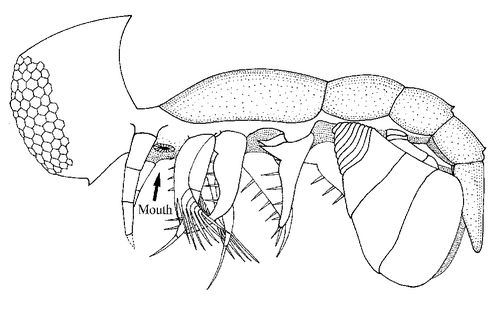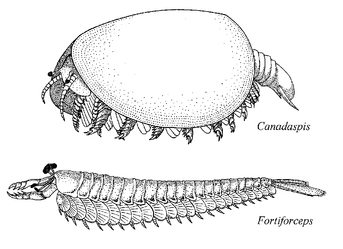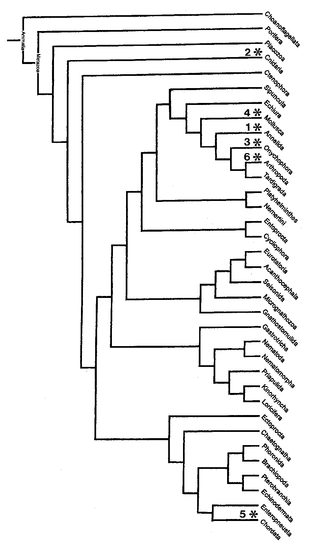In The Blink Of An Eye (34 page)
Read In The Blink Of An Eye Online
Authors: Andrew Parker



Figure 7.10
The Cambrian arthropods
Canadaspis laevigata
and
Fortiforceps foliosa
from Chengjiang, China.
The Cambrian arthropods
Canadaspis laevigata
and
Fortiforceps foliosa
from Chengjiang, China.
The Chengjiang fossils also include many species with eyes. Here there are both stalked eyes that are moveable, and sessile eyes that are fused with the body in any of several possible positions. They can arise from the underside of the animal, extending forwards under the front margin of the head shield, such as in
Fuxianhuia
,
Leanchoilia
and
Isoxys
. In
Retifacies
, however, the eyes also sprout from the underside of the body but do not protrude forward. Then again the eyes of Chengjiang animals can also be positioned on top of the body, such as in
Xandarella
.
Fuxianhuia
,
Leanchoilia
and
Isoxys
. In
Retifacies
, however, the eyes also sprout from the underside of the body but do not protrude forward. Then again the eyes of Chengjiang animals can also be positioned on top of the body, such as in
Xandarella
.
Like the Burgess fossils, most if not all eyes in the Chengjiang community belong to the arthropods. And these two fossil assemblages have been used to trace the position of the eye on the body through time. It is believed that the compound eyes of Cambrian arthropods shifted position from the under side to the top side of the body, and became successively incorporated into the shield or shell that covers the head. I am not sure how much we can read into this, but the same event may have taken place independently in another group of arthropods to those considered up till now - the trilobites. I will return to trilobites shortly.
It is interesting that nearly all of the Cambrian animals I have mentioned up to this point are arthropods - they belong to the phylum with hard, external skeletons that include crabs and insects. But during my description of eyes in animals today in the first half of this chapter, other phyla were very much involved. There were the swimming alciopid bristle worms in the
annelid
phylum (1), box jellyfishes in the
cnidarian
phylum (2), velvet worms in the
onycophoran
phylum (3), cuttlefishes and snails in the
molluscan
phylum (4), and of course ourselves in the
chordate
phylum (5). These animals all have image-forming âsimple' eyes. Then there were the ark clams within the
molluscan
phylum (4), and the fan worms within the
annelid
phylum (1) that, along with the arthropods (6), possess image-forming âcompound' eyes. But do any of these non-arthropod animals have Cambrian ancestors with eyes?
annelid
phylum (1), box jellyfishes in the
cnidarian
phylum (2), velvet worms in the
onycophoran
phylum (3), cuttlefishes and snails in the
molluscan
phylum (4), and of course ourselves in the
chordate
phylum (5). These animals all have image-forming âsimple' eyes. Then there were the ark clams within the
molluscan
phylum (4), and the fan worms within the
annelid
phylum (1) that, along with the arthropods (6), possess image-forming âcompound' eyes. But do any of these non-arthropod animals have Cambrian ancestors with eyes?

Figure 7.11
The evolutionary tree of animals at the level of phyla (all those with representatives alive today are included; note that Choanoflagellata is not a true multicelled group). Asterisks mark the phyla with eyes (which are also numbered 1 to 6 as they appear in the text). Modified from a paper by Rouse and Fauchald.
The evolutionary tree of animals at the level of phyla (all those with representatives alive today are included; note that Choanoflagellata is not a true multicelled group). Asterisks mark the phyla with eyes (which are also numbered 1 to 6 as they appear in the text). Modified from a paper by Rouse and Fauchald.
The answer to this question can obviously be âno' when the eyed group did not evolve within its phylum until after the Cambrian, as determined from computer-generated predictions of the evolutionary tree. This applies to the cuttlefish group, a branch within the mollusc phylum. In fact the most primitive molluscs, which date back to the Cambrian, are eyeless. For similar reasons, the groups of bristle worms with eyes today can also be ruled out of the Cambrian eye club. So who is left in this ancient visual circle after the first round of elimination? The contenders now are the arthropods (1) and chordates (2), who together boast the majority of eyes today, and velvet worms (3) and box jellyfish (4).
The box jellyfish and velvet worms can be discarded as hosts of Cambrian eyes, because they probably can't see as such today. Both groups probably cannot see images that flow through the brain like the frames of a movie. The box jellyfish has no brain with which to interpret the information coding for a series of images, and its single eye remains very much a mystery. The eyes of velvet worms do not produce proper images, but are probably rather adapted to movement - they notice the approach of fast-moving individuals, but cannot make identifications. These organs may virtually bypass the brain. In true eyes, an image is assembled in the brain. The brain then makes a decision on how to react, and has the whole body at its disposal. In the case of the box jellyfish and velvet worms, as well as the bristle worms with compound eyes, their âvisual organs' may simply be binary detectors. A visual signal is interpreted by the organ as either react or do nothing. A camouflaged velvet worm may freeze when a fast-moving animal approaches. The brain is not needed during this process - the detector is wired directly to the muscles that perform the single response. This form of detection has nothing to do with vision. And to substantiate this further, the fossils of box jellyfish and velvet worms provide no evidence of eyes in the Cambrian. So now our list is reduced to just the arthropods and chordates.
Sometimes relatives of today's eyed species did exist in the Cambrian. To decide whether these ancestors, or indeed any extinct group, possessed eyes in the Cambrian, we must turn to Cambrian fossils and the law of minimum eye size.
There are few chordates known from the Cambrian. The best known are
Pikaia
from the Burgess Shale, and the earliest of all
Haikouella
from Chengjiang. Fossils of
Pikaia
reveal a clear body outline along with fine details of internal parts, including muscles and a notochord, a kind of backbone. But features of the front end of the animal are too small to be seen without a microscope. They are, consequently, too small to be eyes. The same can be said of all Cambrian chordates - they could not see.
Pikaia
from the Burgess Shale, and the earliest of all
Haikouella
from Chengjiang. Fossils of
Pikaia
reveal a clear body outline along with fine details of internal parts, including muscles and a notochord, a kind of backbone. But features of the front end of the animal are too small to be seen without a microscope. They are, consequently, too small to be eyes. The same can be said of all Cambrian chordates - they could not see.

Today most blind chordates live in environments with extremely little or no light. Think of the mole. And then there is the Mexican cave fish that has eyes where light is present, and no eyes where light is absent. But there are at least two species of chordate known from the Cambrian, and they lived in sunlit environments. Indeed, many of their neighbours had eyes. So where most of this group have eyes today, why did they not in the Cambrian? This is not what we would expect. The idea that life happened in the Cambrian as it continues today fits for arthropods - they can see now and they could see then. And most modern chordates can see.
So far I have considered that the eye evolved at only one point in time, and that all eyes in existence today stem from that ancestral organ. This implies that the eye must have evolved before the divergence on the evolutionary tree of all animals with eyes. The animal with the ancestral eye must have been the ancestor to the arthropods, chordates, bristle
worms and molluscs - animals with eyes today. In which case the eye must have evolved hundreds of millions of years before the Cambrian explosion, when these phyla diverged from each other (albeit remaining within similar, soft bodies). Things, however, did not happen this way.
worms and molluscs - animals with eyes today. In which case the eye must have evolved hundreds of millions of years before the Cambrian explosion, when these phyla diverged from each other (albeit remaining within similar, soft bodies). Things, however, did not happen this way.
There
are
chordates living in sunlit environments today that have no eyes. They are the most primitive forms of chordate - the type that existed in the Cambrian. I refer to the hagfish, and animals even more primitive. If the most âprimitive' chordates did not possess eyes but the more derived chordates did, this means that the first chordate eye evolved at some point
within
the chordate branch of the evolutionary tree. And now we can justify the lack of chordate eyes in the Cambrian - the eye has a multiple origin. It evolved on more than one occasion - the arthropod eye evolved and the chordate eye evolved, but independently and, it seems, at different points in evolutionary history. When the chordates first branched out from the evolutionary tree they did not have eyes. And the same goes for all other phyla. Now it seems
more
than possible that an eye appeared on Earth in one phylum before any others - it seems veritable. And that phylum with the first eye was the Arthropoda.
are
chordates living in sunlit environments today that have no eyes. They are the most primitive forms of chordate - the type that existed in the Cambrian. I refer to the hagfish, and animals even more primitive. If the most âprimitive' chordates did not possess eyes but the more derived chordates did, this means that the first chordate eye evolved at some point
within
the chordate branch of the evolutionary tree. And now we can justify the lack of chordate eyes in the Cambrian - the eye has a multiple origin. It evolved on more than one occasion - the arthropod eye evolved and the chordate eye evolved, but independently and, it seems, at different points in evolutionary history. When the chordates first branched out from the evolutionary tree they did not have eyes. And the same goes for all other phyla. Now it seems
more
than possible that an eye appeared on Earth in one phylum before any others - it seems veritable. And that phylum with the first eye was the Arthropoda.
There is one group of arthropods I have yet to examine, a group well represented in the Burgess Shale. These are the trilobites.
Earlier in this chapter I casually added trilobites to the list of arthropods with compound eyes. But I did not suggest the exceptional nature of the trilobite. Compound eyes were common in trilobites, which in turn were common in the Cambrian, so it is appropriate to devote part of this chapter to trilobite eyes.
We know that trilobites reigned in abundance throughout the seas. This reign ended 280 million years ago, but began 543 million years ago, at the beginning of the Cambrian explosion. Four thousand species of trilobites have been identified, and they were particularly successful during the first term of their dominion, when they flourished.
We need not rely on the Burgess Shale and Chengjiang fossils for information about trilobites in the Cambrian. Trilobites are found all over the world and from all periods within the Cambrian - their preservation was not dependent on particularly favourable conditions. And the diversity of Cambrian trilobites suggests they were by far the most
important and ubiquitous arthropods around in the Cambrian. In fact trilobites are believed to be the stem group of all arthropods - they probably wore the prototype shells, or âexoskeletons'. From some groups of trilobites the crustaceans, and later the insects, evolved. From another group the sea spiders, and later the spiders, evolved.
important and ubiquitous arthropods around in the Cambrian. In fact trilobites are believed to be the stem group of all arthropods - they probably wore the prototype shells, or âexoskeletons'. From some groups of trilobites the crustaceans, and later the insects, evolved. From another group the sea spiders, and later the spiders, evolved.
The exceptional preservation of trilobites can be attributed to the constituents of their shells - fossilisation-friendly chemicals. And the conservation of their optics allows us a glimpse into their vision - most trilobites had compound eyes.
The compound eyes of trilobites are different from the true compound eyes of today in that their lenses were made of the mineral calcite. Calcite is widespread on Earth - chalk is calcite, but granular, so that it appears white via scattering. Scattering causes structural colour - a white or blue appearance depending on the size of the scattering elements. The elements, or granules, are relatively large in chalk, which causes all wavelengths in white light to be reflected equally and in all directions. And, as Newton demonstrated, when all wavelengths combine the light appears white. But if the calcite is formed slowly, a perfect crystal results, completely free of granules. This type of calcite is crystal clear, and was the ingredient of trilobite lenses. Today, calcite lenses are found only in bristlestars, relatives of starfish. And these lenses are not part of an eye as such, rather a component in a composite light perceiver comparable to that of some bristle worms. Although all relied on calcite lenses, there were two distinct types of compound eyes in trilobites - holochroal and schizochroal.
Other books
No Lease on Life by Lynne Tillman
Voices of Dragons by Carrie Vaughn
Across Frozen Seas by John Wilson
Pellucidar by Edgar Rice Burroughs
The Road Home by Patrick E. Craig
01. Chasing Nikki by Lacey Weatherford
Archangel of Sedona by Tony Peluso
Grim by Anna Waggener
Mayflower Treasure Hunt by Ron Roy